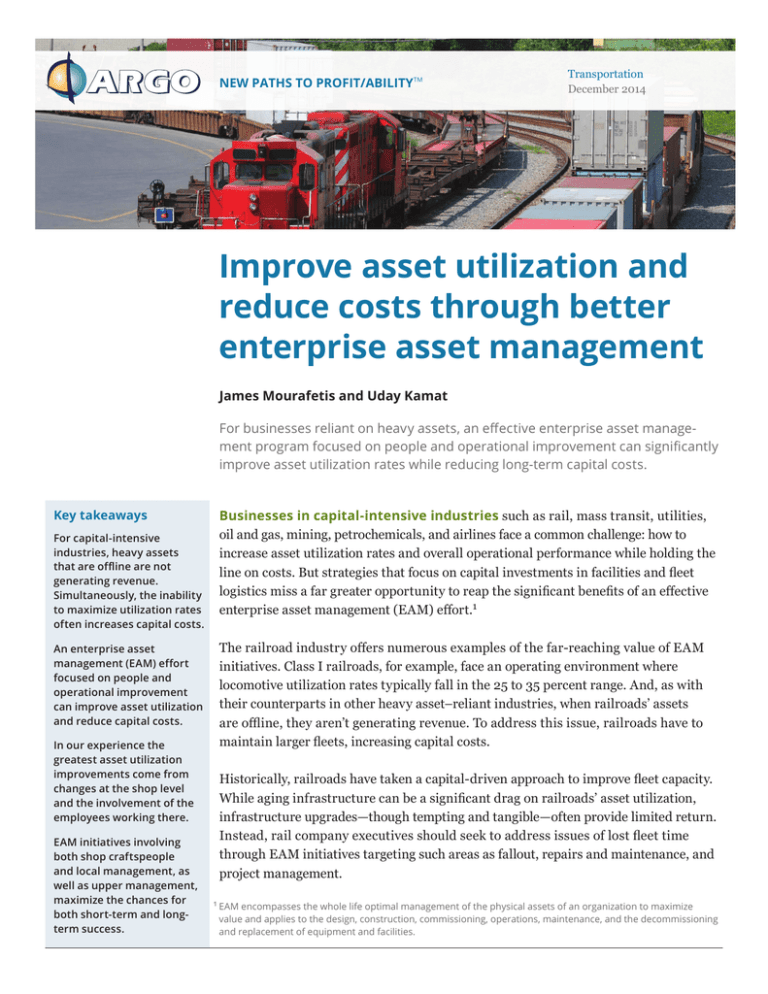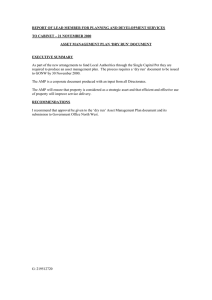
NEW PATHS TO PROFIT/ABILITYTM
Transportation
December 2014
Improve asset utilization and
reduce costs through better
enterprise asset management
James Mourafetis and Uday Kamat
For businesses reliant on heavy assets, an effective enterprise asset management program focused on people and operational improvement can significantly
improve asset utilization rates while reducing long-term capital costs.
Key takeaways
For capital-intensive
industries, heavy assets
that are offline are not
generating revenue.
Simultaneously, the inability
to maximize utilization rates
often increases capital costs.
An enterprise asset
management (EAM) effort
focused on people and
operational improvement
can improve asset utilization
and reduce capital costs.
In our experience the
greatest asset utilization
improvements come from
changes at the shop level
and the involvement of the
employees working there.
EAM initiatives involving
both shop craftspeople
and local management, as
well as upper management,
maximize the chances for
both short-term and longterm success.
Businesses in capital-intensive industries such as rail, mass transit, utilities,
oil and gas, mining, petrochemicals, and airlines face a common challenge: how to
increase asset utilization rates and overall operational performance while holding the
line on costs. But strategies that focus on capital investments in facilities and fleet
logistics miss a far greater opportunity to reap the significant benefits of an effective
enterprise asset management (EAM) effort.1
The railroad industry offers numerous examples of the far-reaching value of EAM
initiatives. Class I railroads, for example, face an operating environment where
locomotive utilization rates typically fall in the 25 to 35 percent range. And, as with
their counterparts in other heavy asset–reliant industries, when railroads’ assets
are offline, they aren’t generating revenue. To address this issue, railroads have to
maintain larger fleets, increasing capital costs.
Historically, railroads have taken a capital-driven approach to improve fleet capacity.
While aging infrastructure can be a significant drag on railroads’ asset utilization,
infrastructure upgrades—though tempting and tangible—often provide limited return.
Instead, rail company executives should seek to address issues of lost fleet time
through EAM initiatives targeting such areas as fallout, repairs and maintenance, and
project management.
1 EAM encompasses the whole life optimal management of the physical assets of an organization to maximize
value and applies to the design, construction, commissioning, operations, maintenance, and the decommissioning
and replacement of equipment and facilities.
2
Improve asset utilization and reduce costs through better enterprise asset management
Although EAM requires a sustained commitment to change and an understanding
of organizational factors, it can also substantially increase workforce productivity and
improve the efficiency of asset use, producing a direct and ample impact on the
bottom line and even conferring a competitive advantage. The key to railroads’ EAM
success is a simultaneous focus on both strategy and implementation as executives
follow a four-step process.
EAM can increase productivity, reliability, and safety
EAM has tremendous potential to boost railroads’ performance in three areas:
•Productivity—For the typical railroad, there is a 65–70 percent operating
ratio, which means the cost to operate is 65–70 percent of revenue. So
railroads that optimize workforce efficiency can handle 5–10 percent year-onyear growth while bending the cost curve.
•Reliability—Improvements in fleet maintenance can boost asset utilization
rates and extend the life of rolling stock, allowing railroads to reduce the size
and frequency of investments in their fleets.
•Safety—Improved fleet maintenance can lower accident rates and increase
public safety.
Given the long time horizon for return on investment on railroads’ capital
expenditures—a locomotive can be in service for 40 to 50 years—operating expense
reduction and workforce improvement efforts offer opportunities to realize yearon-year growth while reducing unit cost.
The philosophy behind EAM
To be effective, your EAM initiative must focus on both top-down and bottom-up
elements. A top-down approach should define the strategy and goals of the initiative.
Meanwhile, the bottom-up approach should focus on gaining workforce input and
The greatest improvements in asset utilization
come from changes at the shop level and the involvement
of the employees working there.
Improve asset utilization and reduce costs through better enterprise asset management
3
buy-in that can ease implementation of the strategy. Cross-functional teams,
consisting of both management and frontline workers, are critical to increasing the
collaboration necessary for success, visibility of overarching goals, and engagement throughout the organization.
The four steps of EAM implementation
To be effective, the EAM process should involve four steps:
1. Identify assets and measures. First, executives must gather data to answer
three essential questions about the asset:
•Utilization—How often is the asset in use?
•Reliability—How well does the asset work?
•Unit cost—How much does it cost to use the asset?
An additional key element of this step is determining an asset performance
index (API), for example, the percentage of time a locomotive is actually pulling
railcars. Examining the API in comparison with the various factors contributing to time not spent pulling railcars provides a telling picture of the asset’s
current utilization and potential areas for improvement (Exhibit 1).
Exhibit 1: Assessment by time loss category
Road fleet time lost from not pulling railcars, including time loss due to reliability vs. utilization performance
Time bucket breakdown—sample week
API: Time pulling freight
Train to train: Train connection dwell
Intermediate: Crew change points
Utilization
LOR: On the road failure
Reposition: Moving locomotives around
Fallout: Time loss due to reliability failures
Reliability
Repair: Repair and PM dwell
Other
Total Time
Improve asset utilization and reduce costs through better enterprise asset management
4
2. Create an asset vision for the future. Benchmarks from other heavy-asset
industries can be used to set realistic targets, allowing for differences in
systems and approaches between industries. Meanwhile, executives should pull
together cross-functional teams to redesign workflows and achieve the desired
improvements. This enabling of collaboration will help ensure buy-in from those
on the shop floor who will be directly affected by process changes and maximize
the chances for the EAM initiative’s success (Exhibit 2).
Exhibit 2: Utilization by Class I railroads compared with other heavy-asset industries
Heavy-asset industries by utilization percent
Locomotive
RR average
Airlines
25%
50%
Trucking
Mining
75%
Automotive
Water and
utilities
Mid-stream
oil and gas
100%
Asset performance comparison
Stable, reliable
performances
through process
improvement
Real-time asset
knowledge
•Location
•Condition
•Performance
Infrastructure
Automation
Rapid deployment
systems
Targeted maintenance
3. Develop work streams to align and prioritize actions. Maximizing
asset utilization is contingent on identifying the various factors contributing to
time-loss buckets and targeting improvements to reduce those losses. For
each work stream, a top-level work plan should be developed that clearly defines
its current and future state and measures the unit cost impact of planned
improvements. Along the way, value is created by linking project deliverables to
API improvements. The chain of command should look something like this:
•Champions should be assigned for each work stream to lead reviews with
project teams and periodically present project performance to an asset
management team.
5
Improve asset utilization and reduce costs through better enterprise asset management
•That asset management team in turn reports to an asset committee charged
with devising strategies to remove work stream roadblocks.
•Ultimately, governance over the initiative is overseen by a senior
management steering committee that reports progress quarterly to the chief
operating officer.
4. Deliver productivity results through EAM integration and value
analysis/value engineering. This stage begins with identifying what matters
through on-site analysis. Next is the development of capable processes by
organizing repair and testing processes in a systematic manner. Site improvement councils should be created to develop and install the critical success
factors that will drive continuous improvement while a quality council should
be developed to eliminate defects. Detailed road maps and timelines aligned
with specific targets will help achieve the desired short-term results of improved
workforce efficiency and asset utilization along with the long-term goals of
reducing needed capital investments. Finally, improvements can be locked in by
integrating EAM to achieve sustainability and by employing value engineering
over the long term.
Realizing the benefits of an effective EAM initiative
In our experience, the benefits realized by Class I railroads that employ a successful
EAM initiative can be significant. One railroad, for example, set a long-term goal
of improving its asset performance by 25 percent over a 15-year timeline, with every
1 percent improvement in the railroad’s API equivalent to a 1 percent improvement in asset uptime. After working through an EAM process as outlined above, the
railroad is on course to reduce locomotive mechanical operating costs through
a fleet reduction of 25 percent. Among the improvements in shop-level performance
produced by the EAM effort are a 30 percent reduction in incidents related to poor
quality after shop release, a 20 percent improvement in on-time release from the shop,
and a 15 percent improvement in craft wrench time.
In another case involving a railroad looking to reduce the amount of time needed
to repair and/or replace wheels on its car fleet, an EAM effort produced 46 percent
improvement in wheel repair time, a 45 percent improvement in documentation
work, and a 46 percent improvement in repair prep work.
A third case involved an operator looking to reduce yard dwell time; the EAM initiative produced a 19 percent improvement in service island dwell time and a
12.2 percent improvement in locomotive maintenance dwell. The EAM initiative has
also produced the added benefit of increasing visibility among previously siloed
units. And that increased visibility along with the collaboration among management and
shop workers has improved morale and enabled sustained efficiency improvements.
6
Improve asset utilization and reduce costs through better enterprise asset management
Is EAM right for you?
Many companies in heavy asset–reliant industries believe they already have a great
asset management strategy, but the fact is the greatest improvements in asset
utilization come from changes at the shop level and the involvement of the employees
working there. Workflow process changes determined at the highest level of the
organization and then handed down to the shop floor are destined to produce unsatisfactory results. Instead, the best enterprise asset management outcomes arise
from initiatives that involve both craftspeople in the shop and local management as
well as upper management. Such coordinated efforts will not only maximize
chances of achieving desired results in the short term but also provide for the sort of
long-term, high-level support that will help ensure the improvements’ sustainability.
For a heavy asset–reliant business used to taking a long-term view of its capital
assets, the benefits of an effective EAM initiative are clear: immediate gains
in productivity and asset utilization that can lead to long-term savings in operating
costs and capital expenditures.
About the authors
James Mourafetis is a Senior Vice President with Argo and leads its Railroad and Public Transportation
practice worldwide. He specializes in enterprise asset management. Uday Kamat is a Vice
President with Argo and specializes in deployment of asset management tools at Class I railroads to
improve safety, reliability, and availability.
Copyright © 2014 Argo, Inc. All rights reserved.
Photography: © iStock.com/Tony Tremblay


